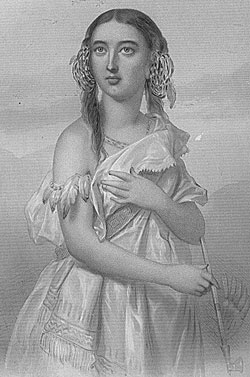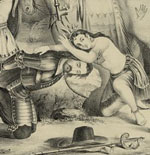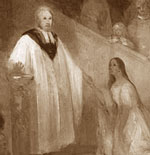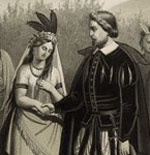|
Digital
History>eXplorations>Pocahontas
and Squanto

Pocahontas
In
a volume recounting the history of the English colony
in Virginia, Smith describes a famous incident in which
Powhatan's
12-year-old daughter, Pocahontas (1595?-1617), saved
him from execution. Although some have questioned whether
this
incident took place (since Smith failed to mention
it in his Historie's first edition), it may well have
been
a "staged
event," an elaborate adoption ceremony by which
Powhatan symbolically made Smith his vassal or servant.
Through
similar ceremonies, the Powhatan people incorporated
outsiders into their society.
Pocahontas
reappears in the colonial records in 1613, when she was
lured aboard an English ship and held captive. Negotiations
for her release failed, and in April 1614, she married
John Rolfe, the colonist who introduced tobacco to Virginia.
Whether this marriage represented an attempt to forge
an alliance between the English and the Powhatan remains
uncertain.Their marriage created a climate of peace between
the colonists and Powhatan's tribes for several years.
For
a few years after the marriage, the couple lived together
at
Rolfe's plantation and
had a child, Thomas Rolfe, born on January 30, 1615.
There are around 30,000 descendents today of this union.
|

|
In
1616, the Rolfe family traveled to England, arriving
at the port of Plymouth on the 12th of June. They were
accompanied
by a group of around eleven other Powhatan natives including
Tomocomo, a holy man. Pocahontas called the "Indian
Princess" and receives an audience with King James
I and Queen Charlotte.
In
1617, Rolfe and Pocahontas boarded a ship to
return to Virginia, but she became ill and died. She
was taken ashore at Gravesend on the River Thames. Rolfe
wrote from Virginia “My wife’s death is much lamented:
my child
much desired. When it is of better strength to endure
so hard a passage, whose life greatly extinguished
the sorrow of her loss, saying all must die. But ‘tis
enough
that her child liveth.”
Her funeral took place on March 21, 1617 in the parish
of Saint George's, Gravesend. Her memory is recorded in
Gravesend with a life-size bronze statue. |
| Timeline of the life of Pocahontas: |
| 1595 |
Birth of Matoaka, later nicknamed Pocahontas.
She is the eldest daughter of the powerful Indian leader,
Powhatan. |
| 1607 |
 |
According to Captain John Smith's account,
Pocahontas saves him from execution, thus initiating a friendly
relationship with him and other Jamestown settlers. |
| 1612 |
Pocahontas captured by the English captain Samuel Argyll
and used as a political pawn in his dealings with her father. |
| 1613 |
 |
While in captivity, Pocahontas learns about Christianity
from an English minister, Alexander Whitaker, who also helps
her improve her English.
After
she
was baptized, her name was changed to Rebecca. |
| 1614 |
 |
She marries John Rolfe, and their son, Thomas, is born
the next year. |
| 1616 |
To great fanfare, Pocahontas travels to England
as the "Indian
Princess" and receives an audience with King James I
and Queen Charlotte. Simon Van de Passe executes the only
portrait done in her lifetime. |
| 1617 |
Pocahontas becomes ill and dies as she is leaving
England to return to Virginia. She is supposedly buried
in St. George's Church, Gravesend, England. |
|
